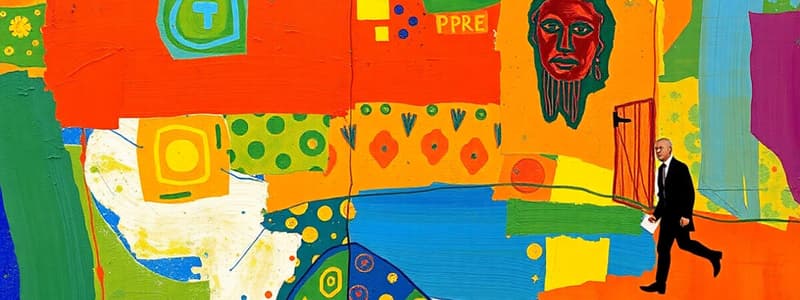Podcast
Questions and Answers
The PPP method emphasizes fluency during the Practice stage.
The PPP method emphasizes fluency during the Practice stage.
False (B)
The teacher's role remains unchanged throughout all stages of the PPP method.
The teacher's role remains unchanged throughout all stages of the PPP method.
False (B)
Repetition and reinforcement are utilized to help students internalize new language concepts in the PPP method.
Repetition and reinforcement are utilized to help students internalize new language concepts in the PPP method.
True (A)
The PPP method does not allow for adaptation to students' individual needs.
The PPP method does not allow for adaptation to students' individual needs.
The PPP method starts with a free learning environment before practicing new language structures.
The PPP method starts with a free learning environment before practicing new language structures.
The Presentation, Practice, Production method originated in behaviorist theories from the mid-20th century.
The Presentation, Practice, Production method originated in behaviorist theories from the mid-20th century.
The audiolingual method became popular before World War II.
The audiolingual method became popular before World War II.
The PPP method emphasizes practice through repetition and drills.
The PPP method emphasizes practice through repetition and drills.
The 'Production' stage of the PPP method allows students to use language in a rigid manner.
The 'Production' stage of the PPP method allows students to use language in a rigid manner.
Critics of the PPP method argue that it is too flexible and allows for varied methods of teaching.
Critics of the PPP method argue that it is too flexible and allows for varied methods of teaching.
The PPP method is a structural approach that systematically teaches language elements.
The PPP method is a structural approach that systematically teaches language elements.
The gradual introduction of language concepts occurs primarily in the Practice stage of the PPP method.
The gradual introduction of language concepts occurs primarily in the Practice stage of the PPP method.
Proponents of the PPP method appreciate its clear structure, especially for advanced learners.
Proponents of the PPP method appreciate its clear structure, especially for advanced learners.
Flashcards
PPP Method Stages
PPP Method Stages
The PPP method has three stages: Practice, Preparation, and Production. It moves from highly structured practice, to less structured production.
Practice Stage Focus
Practice Stage Focus
In the Practice stage of PPP, the main goal is accuracy in using new language structures.
Production Stage Focus
Production Stage Focus
The Production stage encourages fluent and creative language use.
Sequential Learning in PPP
Sequential Learning in PPP
Signup and view all the flashcards
Teacher's Role in PPP
Teacher's Role in PPP
Signup and view all the flashcards
PPP Method
PPP Method
Signup and view all the flashcards
Presentation Stage
Presentation Stage
Signup and view all the flashcards
Practice Stage
Practice Stage
Signup and view all the flashcards
Production Stage
Production Stage
Signup and view all the flashcards
Behaviorism and Structuralism
Behaviorism and Structuralism
Signup and view all the flashcards
Audiolingualism
Audiolingualism
Signup and view all the flashcards
Communicative Language Teaching
Communicative Language Teaching
Signup and view all the flashcards
Gradual introduction
Gradual introduction
Signup and view all the flashcards
Study Notes
Presentation-Practice-Production (PPP) Method
- PPP is a structured language teaching method used for second languages
- Roots in behaviorism and structuralism (early 20th century)
- Focuses on observable behaviors and reinforcement
- Audiolingualism (1940s-1960s)
- Popular after WWII, especially in the US
- Emphasized repetitive drills and pattern practice
- Similar emphasis on practice as PPP through repetition and drills
- Communicative Language Teaching (1970s-1980s)
- A reaction against audiolingualism's perceived artificiality
- Focus on communication and realistic language use
- Structural Approach
- Focuses on language elements (vocabulary, grammar) in an organized manner
- Contemporary Views and Criticisms
- Criticized for being too linear and teacher-centered
- Proponents value its clear structure and ease of use, especially for beginners
Principles of PPP
- Gradual Introduction of Language Concepts
- Language concepts introduced clearly, understandably, and contextually
- Gradual introduction to avoid overwhelming learners
- Controlled to Free Learning Environment
- Transition from a controlled practice phase to a more open production phase
- Allows students to first practice language in a structured way before free use
- Emphasis on Accuracy and Fluency
- Practice stage emphasizes accuracy; Production stage transitions to fluency
- Sequential Learning
- Method is sequential, each stage builds upon the previous one
- Ensures each stage is understood and mastered before progressing
- Repetition and Reinforcement
- Repetitive exercises/drills in the practice stage reinforce and aid in memorization
- Teacher's Role as Facilitator and Guide
- Initial stages, teachers are central in presenting new material and guiding practice
- Production stage, teacher transitions to facilitator, offering support and feedback
Balancing Form and Function
- Balances teaching form (grammar, structure) and its function (its use in context in communication)
Adaptability to Students' Needs
- The method is structured but allows for adapting to diverse needs, levels, and learning styles
- Teachers can modify activities and pacing based on class progress and feedback
Studying That Suits You
Use AI to generate personalized quizzes and flashcards to suit your learning preferences.



